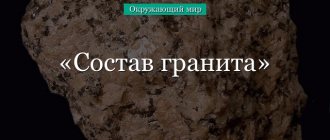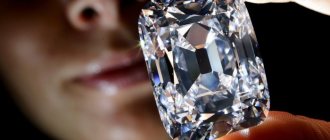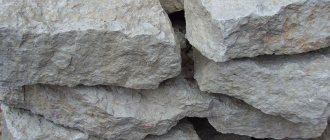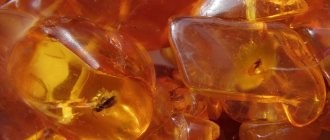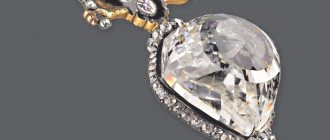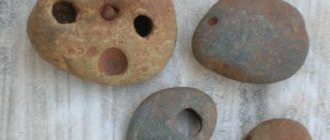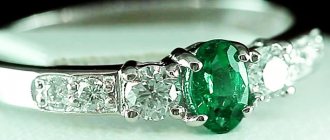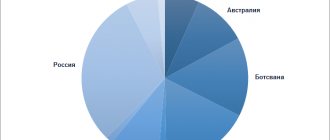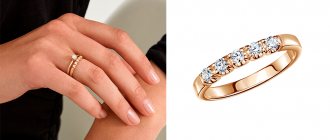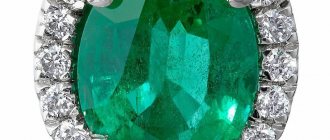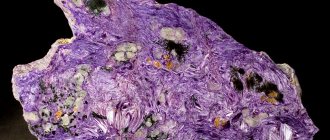What are stones? Origin of stones
Stones are solid bodies that are non-living rocks. Most often, stones are formed from other stones. For example, if you drop a stone from a great height, it will break into many smaller stones.
Eruption
But there is another way to form them. During volcanic eruptions, lava, a substance heated to enormous temperatures, is ejected from the depths of the Earth to the surface. As it cools, stones form.
Slide captions:
THE AMAZING WORLD OF STONES Responsible: teacher-speech therapist Statkevich E.O. educators Mashalgina G.P. Budantseva O.I. GBDOU kindergarten No. 34 2015
Goal: Expand knowledge about the variety of stones and their properties Objectives: Introduce children to the concept of “stone” Introduce children to the groups into which stones are divided Introduce children to the most famous stones - Introduce stone products
Stone - (Old Slavonic “kamy”). Hard mineral material (rock mass). Basically, rocks or precious stones (diamond, diamond, etc.) are called stones. They come from the Ukrainian “kamin” - “mountain”.
Stones are as integral a part of nature as plants and animals. But the world of stone is older than the living world. In Rus', rings with stones were worn in ancient times.
Belief in the mysterious magical power of precious stones has existed since ancient times, so they were purchased as amulets and talismans that protect against hostile forces and bring happiness, curing all diseases. The three main virtues of precious stones - beauty, durability, rarity - set them apart from the world of inanimate nature.
There are many different stones in the world in shape and size. Group I - precious stones (gems) diamond, ruby, sapphire, emerald, alexandrite, topaz, aquamarine, garnet, turquoise, rock crystal and others. Group II - ornamental (colored stones) jade, lapis lazuli, glavcolite, sodalite, amazonite, labradorite, rhodonite, azurite, malachite, jade, lapis lazuli, glavcolite, sodalite, amazonite, labradorite, rhodonite, azurite, malachite, gypsum. Group III - organogenic precious stones: pearls, coral, amber, jet.
The most famous of all stones is DIAMOND. Diamond - the name of the most famous precious stone comes from the Greek "adamos", which means irresistible or indestructible, and the Arabic "almas" - the hardest. The main distinguishing features of diamond are the highest hardness among minerals (but at the same time fragility). Jewelry-quality colored diamonds can be born in absolutely any color, tone, hue, saturation... The most common are lemon yellow and blue stones, less often - red, green, violet, purple... Even more rare - pink... The rarest are natural black diamonds, for Throughout the entire history of diamond mining, only a few hundred such stones have been found and documented... The first diamonds were found in India. From ancient Indian sources it follows that this happened about three thousand years BC. DIAMOND
DIAMOND PRODUCTS
Preview:
To use presentation previews, create a Google account and log in to it: https://accounts.google.com
Types of stones
Diamonds
All stones can be divided into three large groups. The first group includes precious stones. They are used in making jewelry. These are diamond, sapphire, ruby. Such stones are beautiful and rarely found in nature. It is important to note that gemstones can also be used in industry. For example, diamond is used as a cutting material, because it is the hardest substance in nature.
Quartz
The second group is semi-precious stones. They are much cheaper than precious ones, but are also used in the manufacture of luxury goods. These include crystal and quartz. Chandeliers, dishes and other interior items are made from crystal.
Marble Quarry
The most common stones are included in the third group - ornamental stones. They are used in everyday life, primarily in construction. Examples of such stones are granite and marble.
Selection of stones for crafts (Sea, semi-precious, river.)
Most often, the choice of stones for such crafts is based on the principle of “what is at hand.” The first one that comes to mind, of course, is sea or river pebbles; these pebbles are great for coloring, creating toys, mosaics and rugs.
The complexity and size of the craft in this case are limited only by resources and your imagination. The main advantage of this material is its diversity; nature creates pebbles of various sizes and shapes, and they are easy to combine to achieve the desired result.
Semi-precious stones are more suitable for creating simple jewelry and will be more interesting to girls. You can make a cute necklace or ring.
In addition, these types of stones can be combined, for example, small semi-precious stones can be used instead of eyes on toys made from pebbles.
Breaking stones
Stones seem to be very strong and solid bodies. However, even they are gradually being destroyed. The easiest way to crush a stone is to hit it hard or drop it from a height. But in nature there are several other reasons that cause the destruction of stones.
First of all, these are temperature fluctuations. It is known that many substances, including stones, expand when heated and contract when cooled. At the same time, the stones warm up unevenly in the sun - the sunny side is stronger. As a result, one part of the stone expands and tries to expand another part of the stone that is not heated. This process can lead to the formation of very small cracks - microcracks. If a stone has cooled and heated up many times, then the cracks grow strongly and gradually destroy the stone.
If a stone is located near water (on the banks of a river or sea) and is constantly rolled around by waves, then it will change shape. Many people have noticed that the stones on the beaches are smooth and even. This is a consequence of the influence of water - it destroys the stone, and various protrusions are destroyed faster. You could say that water literally polishes the stone.
Sometimes water and temperature work together. If water gets into a crack in a stone, it will turn into ice at low temperatures. It is known that when water freezes, it expands, that is, the ice will begin to put pressure on the walls of the crack and will expand it.
Destroys stones and wind. It acts almost the same as water, however, since air is much lighter than water, the destruction process is longer. If there are a lot of dust particles in the air, it destroys the stone faster.
Types of natural stones for health
- Aventurine.
This type of natural stone, such as aventurine, can relieve various rashes, neurodermatitis, allergic dermatitis, and cope with hair loss. Jewelry with aventurine normalizes blood pressure. This stone will help people suffering from diseases of the cardiovascular system and blood circulation. In addition, it can be used to heal a wound or get rid of a wart. This mineral is worth having on hand. In addition to jewelry, special massage balls are made from aventurine.
- Agate.
This type of natural stone (pictured below), like agate, will help if you cannot get rid of a cough for a long time and often suffer from throat diseases. In addition, it cleanses the body of toxins and also helps normalize the acidity of gastric juice.
In addition, with the help of agate you can get rid of stress and overcome various fears. Agate beads will bring relief to asthmatics, as well as those who are susceptible to bronchitis or suffer from toothaches. Blue agate is suitable to combat the manifestations of osteochondrosis, and green agate is suitable for diseases of the cardiovascular system and pancreas.
The difference between stones and metals
Not every solid object in nature is a rock. There are also metals. For example, pavements are made from stone (this is a type of covering for city streets), and sewer manholes are made from metals. But how are metals and stones different?
It turns out that metal can be melted (to do this it must be heated very much) and poured into some form. After cooling, we will get a new metal object, and the properties of the material will be preserved. This process is called casting and is used in industry to make parts. But stones cannot be cast. Some stones simply burn when heated, while others change their properties too much. Metals have many other distinctive properties that are studied in physics and chemistry lessons.
Types of natural stones that can destroy a family
However, a number of minerals have a less clear effect on a person and his relationships with other people. Let us dwell in a little more detail on those natural stones, their types and names that can cause harm. However, even if you have certain knowledge, do not forget to listen to your own intuition. It is quite possible that a stone that carries a negative charge for others will, on the contrary, bring happiness and love into your life.
- Amethyst.
This stone is popularly called the “stone of new love” or “the stone of old bachelors.” It can easily evoke feelings towards the person giving it, even if the recipient is not free. The energy of this stone is such that it can cause indifference to a partner in an existing relationship, opening a vessel for filling new love.
Amethyst is especially dangerous for married women. Jewelry with this stone is not given to young girls or other people's wives. Some nations adhere to a custom according to which one of the spouses who have lost their soul mate and do not want to start a new family wears an amethyst as a symbol of eternal love for the departed spouse.
- Alexandrite.
Some peoples give it a bad name, calling it the “widow’s stone.” According to ancient belief, a woman wearing such jewelry will remain unmarried forever, and if she is married, she will not find happiness in it and will eventually become a widow. However, girls who have tender feelings for this stone need not fear the consequences if they wear it in pairs.
- Opal.
The history of this stone is not clear. On the one hand, it is called a talisman of love, and on the other, it is believed that its presence brings love failures into life. For the same person, opal can serve as a talisman, protecting against base desires and whims, or, on the contrary, it can push one to receive forbidden pleasures.
Jewelry containing this mineral should be given with great care. Keep in mind that such a gift may cause a negative attitude towards the giver. An interesting feature is that the higher the value of the gift, the more hatred it can cause towards you.
GEMS STONES for games, hobbies and entertainment;)
There is reason to remind you of our last trip around the world. The search for real pirate treasure turned out to be so exciting that we wanted to stay a little longer on the island, and at the same time talk about our games with the precious treasure we found. So, bewitching, delightful natural gemstones “Pirate’s Treasures”
These magic stones have enormous developmental, educational, correctional, therapeutic and cognitive potential.
The stones will be interesting and useful for both babies from one year old and older children, boys and girls, “special” children, and even adult mothers and fathers. It is a great tactile and aesthetic pleasure to touch them, feeling their smoothness and roughness, heaviness and lightness, coolness gradually disappearing from the warmth of the palm. And how pleasantly they tap when touching each other...
And most importantly, with stones you can play all sorts of tactile, mathematical, speech, creative games and even start collecting gems! But first things first!
In addition to the stones themselves, in the treasured box you can find a map and a colorful booklet from the manufacturer, which offers various examples of activities and games with stones.
You will learn how to collect stones, search for gem deposits on the map, sort them by color, shape, weight, texture; use stones for sensory boxes, lay out various patterns and shapes; and how to use stones to develop perception, mathematical abilities and simply create! I must admit that the stones themselves are truly magical - they will definitely inspire you to come up with more and more new games. Don't believe me? Then see for yourself!
Even the youngest researchers, as early as one year old (naturally, under the supervision of their mother), can be asked to put pebbles into a plate - to play an exciting game “Boom!”, useful for sensory development, development of perception, hand coordination and finger grip. Kids really like to play like this, because it’s not only fun, but also loud! And a little later you can complicate the movement using a spoon. Observing the game moment, feed a bear, a doll, any toy that has sunk into your soul with a spoon, or you can make a slot in the box - we showed a similar game in the review with berry games.
When the baby grows a little, use gems as counting material. The plot of the game will tell you the age, capabilities and interests of your little explorer.
You can harvest apples and bake berry pie.
Or load/unload stones for construction, compare stones with each other, determining where there are more and where there are less.
Perhaps in winter you want to decorate the Christmas tree,
and in the summer count the pebbles on the sea coast.
How? Is your baby going to school soon? Then study letters with the help of gems and learn to read!
Gemstones are the best material for various homemade board games. From the simplest “Tic Tac Toe”
and to the serious deep board game “Kalah”.
Kalah is one of the oldest board games belonging to the Mancala family of games. This is a logic game for two with simple rules, but with ample opportunities for tactical improvisation. The principles of the game "Kalah" reflect the characteristics of African agricultural cultures. This is evidenced by the structure of the playing field and the designation of player actions. The playing field has indentations called holes, and the player's move symbolizes sowing (in African countries, stones are still replaced with special grains or beans). Thus, the point of the game is to go through the agricultural cycle, from sowing to harvesting the crops in the barn, and the goal of the game is to avoid hunger, a situation when the player’s holes are empty.
Gems are perfect for this game, but the game board is quite easy to make yourself - draw it.
You can play Kalah from 5-6 years old. The game board is located between the players. Both players place 6 stones in each of the 6 holes on their side of the board. The 2 large recesses are called "Kalah" and remain empty at the beginning of the game. Each player has his own Kalah, on his right hand. The starting player is determined by lot.
The first player removes all the stones from any hole on his side. Then, from left to right, he throws one stone into each subsequent hole, as well as into Kalah. The opponent's call must be missed. If the last throw was made at his own Kalah, the player gets the right to one more move, and this operation can be repeated several times. As the game progresses, the recesses become empty on both sides. When a player throws the last of the captured stones into an empty hole on his side on his turn, he captures the opponent's stones in the hole opposite. The player places the opponent's stones in his Kalah. With this, the player ends his turn, and the other participant acts. The game ends when one player has all 6 slots empty. The opponent places all the remaining stones in the recesses into his Kalah. The participant who collects the most stones in Kalah wins.
And the gemstones will definitely inspire you to organize an exciting pirate quest with games, tasks and the search for real treasures. Believe me, such a pirate party will remain in the memory of your elementary school student for a long time!
You don’t have to play something necessarily educational or educational, just have fun with the stones themselves!
Gemstones will definitely be of interest to adults as well. Since ancient times, precious stones and minerals have been used in alternative therapy. It is believed that natural stones can maintain health and restore a person’s inner harmony. Gemstones are a natural material that contains strength and energy coming from the very depths of the Earth! Knowing the beneficial healing properties of stones, you can choose your own individual stone that will help you! So the stones can serve as an incentive for mothers and fathers to study lithotherapy (stone treatment). This means that you will play and learn together with your little ones! What could be better than a family game together?!
I hope we have convinced you that natural stones are not only beautiful, but also very, very useful! Try it too!
PS Today in the BB feed I saw another very interesting mathematical game “Collect a pirate chest”, for which gemstones are ideal.
Materials for printing the game can be downloaded from Jolene
Slide captions:
TURQUOISE Turquoise is one of the most valuable opaque stones used in jewelry. The color of turquoise ranges from faded blue to bright sky blue, almost blue; from yellowish-greenish to almost green. Often turquoise has various inclusions of other minerals (usually black - psilomelane and brown - limonite - colors). Sometimes these inclusions are observed in the veins and are very numerous - this is a “turquoise matrix”. The color of turquoise is very delicate. When heated to just 250 degrees Celsius, the blue color of turquoise turns into a faded green (much less valued). Turquoise is afraid of sunlight, sweat, oils - yellowish spots may appear.
TURQUOISE PRODUCTS
MALACHITE Malachite is an opaque stone with a bizarre pattern of inclusions of all shades of green. The stone gets its name from the Greek “mallow” because its color resembles the color of the leaves of this plant. Pliny the Elder wrote that mala - hit is opaque, but denser and darker than emerald. However, the mineral is valued mainly for its varied texture: ribbon, streamy, concentric, radiant, star-shaped with iridescence. For the first time, a malachite deposit was discovered in ancient times in the Kirmana mountains in the south of Iran among copper mines. Deposits of “Elat stone” are located near the city of Elat in southern Israel. According to the Jewish legend, here once were “the mines of King Solomon.”
MALACHITE PRODUCTS
Preview:
To use presentation previews, create a Google account and log in to it: https://accounts.google.com
